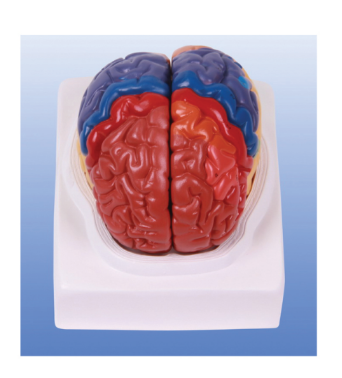09-07-2024
ADA MED SUPPLY LIMITED
The model of cerebral cortex is a very important research field in neuroscience, which reveals the mystery of human higher cognitive function through the fine division and analysis of cerebral cortex. The following is a detailed explanation of how the model of cerebral cortex segmentation is refined and its function is analyzed:

First, the fine division of cerebral cortex
The cerebral cortex, as the most advanced part of the central nervous system, is self-evident in its complexity and delicacy. In order to further study its function, scholars have adopted a variety of partitioning methods, among which Brodmann partitioning method is the most widely accepted and applied. The method, proposed by German neuroscientist Kobinian Brodmann, divides the cerebral cortex into 52 regions (although some regions have been further subdivided as research has progressed). Each region has its own unique cell type, arrangement, and distribution of nerve fibers, which together determine the functional properties of the region.
2. Functional analysis of cerebral cortex regions
Motor area: Mainly located in the anterior central gyrus and paracentral lobules of the brain, responsible for generating and controlling voluntary movement. This region receives sensory information from various parts of the body and integrates this information to coordinate and adjust the movement of the whole body.
Sensory area: Located at the back of the posterior central gyrus and paracentral lobules, it regulates the body's pain, temperature, touch, pressure, and physical sensations such as position and movement. This area is crucial to our perception of our environment and our own state.
Auditory area: Located near the transverse temporal gyrus and lateral fissure, it is responsible for receiving and processing auditory information from both ears. Since the auditory center on each side receives auditory impulses from both ears, damage to one center usually does not result in deafness.
Visual area: Located in the occipital lobe of the cerebral cortex, it is a key area for processing visual information. The visual center on each side is related to the opposite half of the visual field of both eyes, so damage to both visual centers will lead to total blindness.
Language area: For most people, the language area is primarily located in the left hemisphere. Including Broca's area (motor language center), auditory language center, visual motor language center and visual language center, these areas together support our language understanding and expression ability.
Association area: In addition to the above specialized areas, there are also a large number of areas in the cerebral cortex that are not directly involved in sensory and motor processes, called association areas. These regions are mainly responsible for higher cognitive functions, such as attention regulation, spatial memory, personality, emotion, and social behavior regulation.
To sum up, the cortical zoning model provides strong support for us to deeply understand the working principle of human brain by finely dividing and analyzing the functional characteristics of each region. This model not only promotes the development of neuroscience, but also provides important reference and guidance for medical practice.